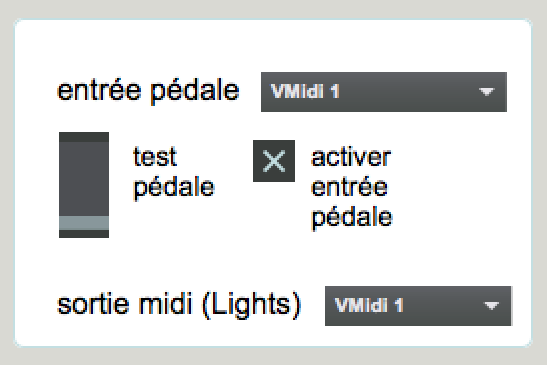Table of contents
Performance date: 8 juillet 2014
Documentation date: 21 novembre 2016
Version state
Valid
Validation date: 30 novembre 2017
Executions dates of this version
- 8 juillet 2014,
Version documentalist
- lemouton (Serge.Lemouton@ircam.fr)
Version realisation
- Grégoire Lorieux (Computer Music Designer)
- Carlo Laurenzi (Computer Music Designer)
Version length
10 mnUpgrade Motivation
- Upgrade to Max7
NOTA BENE:
A mistake in cues placement from cue 4 to the end of the piece was corrected.
Comment
- Performed at the “Computer Music Design Master Class" within the "Manifeste Academy 2014", using Max6.
- Student: Dominik Streicher ; Tutor : Carlo Laurenzi
Other version(s)
Detailed staff
- soliste : 1 basson
Electronic equipment list
Computer Music Equipment
-
1 MacBook Pro - Apple Laptops
(Apple)
-
1 MacBook Pro - Apple Laptops
(Apple)
optional, for cue visualisation -
1 Max 7 - Max
(Cycling74)
-
1 Fireface 800 - Sound Board
(RME)
-
1 BCF 2000 - MIDI Mixer
(Behringer)
-
1 Footswitch / Sustain Pedal - Footswitch / Sustain Pedal
Audio Equipment
-
2 KM184 - Dynamic Microphones
(Neumann)
-
1 DPA 4061 - Condenser Microphones
(DPA)
-
2 Loudspeaker - Loudspeakers
or 4 (optional) -
1 subwoofer - Subwoofers
Work related information
Premiere
- 17 octobre 2002, Paris, Ircam, espace de projection
Publisher :
- Billaudot
Realisation
- Benjamin Thigpen
Work length
- 10 mn
Useful links on Brahms
- Transmission pour basson et électronique (2002), 10mn
- Franck Bedrossian
| File | Author(s) | Comment | |
|---|---|---|---|
| Download [621,7 Mio] | All-in-one patch_all-in-one |
Instructions
General notes
A unique stereo sound file accompanies the bassoon, which undergoes some transformations (filtering, distortion, chorus, frequency shifting).
The bassoonist plays following a click.
A first sound file (introvox.aif), lasting 36 seconds, plays alone at the beginning of the piece. Then the player triggers a second sound file (despair.aif), lasting 9'17", which is synchronized with a click track.
A soundfile with the audiofile "despair" with click superimposed, for practicing purposes, is available in the folder "Practicing CD", for the instrumentalist
Score and recording by bassoonist Martin Brice are also available, respectively in "Score" and "Recording" folders.
Stage Setup
This piece can be played in simple stereo configuration, with 2 loudspeakers, or in double cross stereo configuration, with 4 loudspeakers.

A DPA 4061 microphone is attached to the top of the instrument with an elastic, + two Neumann KM 184 microphones are used, in order to catch both registers of the instrument, corresponding to the position of the hands of the player.
These three microphones are then mixed in mono and then send into both adc 1 + 2 in the patch (same signal for the two channels).
A secondary computer can be set to show cues to the instrumentalist (optional).
Audio and Midi Setup

The sound files from the electronics are output from the audiocard through dac 1 + 2. The electronics can be also output in "cross Stereo" configuration (cross stereo: left channel is output from front left and rear right, while the right channel is output from front right and rear left).
Treatments for the basson are output through dac 3
The click track is output through dac 4
The sound engineer mixes at the console the relationship between the sound files and the treatments.
Patch presentation

Initialization routine
- Set Max file preferences path to the "Patches" folder.
- Set MAX Sampling Rate to 44100
- On the main computer launch the patch _Transmission_2016.maxpat.
- Click on "preload sounds"
- Click on 'reset'
- Put DSP ON
- Choose the MIDI port for the foot-switch pedal
- Ask the performer to test the pedal and check that the slider moves upward.
- Activate the pedal input, to allow triggering.
- Choose the MIDI port for lights midi output (optional control of the lights)
- Setup the secondary computer on stage to visualize the cues, it must be connected in local network with the main computer.
- Check the local network connection between the two computers, the main one and the one onstage to visualize the cues.
- Main computer configuration (the one that plays the sounds and treats the bassoon): click on « bang here to get the + interface IP information for this computer ».
- Launch the _OSC-receive-transmission.maxpat patch on the secondary computer onstage and click on bang here to get the + interface IP information for this computer ".
- Copy the IP of the host computer in the "remote IP here enter" field of the secondary computer (in the textedit object, enter the IP numbers, than click anywhere outside, to send them).
- Copy the IP of the secondary computer in the "remote IP here enter" field of the main computer.
For the beginning of the piece :
- The pedal is used only to trigger the beginning of the piece and then the second sound file. At the Event 1, a message "light" triggers an automatic fade for lights. (These first two MIDI events can be easily executed by hand, in case you want to get rid of the pedal for the bassoonist).
- The events 2 to 17 are then automatically triggered, in synchronization with the second sound file (despair.aif).
- Key "a" can be used to trigger the keys manually.
Midi setup
Click the umenus on the panel on the right side of the patch to choose the midi input for the pedal, and also for the midi output for lights (optional).

Click on the subpath midimix to set the midi input for the BCF2000 midi mixer.

© IRCAM

This documentation is licensed under a Creative Commons Attribution-NonCommercial-NoDerivatives 4.0 International License.
Version documentation creation date: 21 novembre 2016 08:04, update date: 6 mai 2021 15:09